Secluded beaches encased in lush forest and bordered by crystal clear water: there are reasons to look forward to Parque Tayrona. Anthony and I aren’t the biggest beach fans; but we found here the perfect combination of adventure and tranquillity, all set in a mesmerising landscape. Here, high-end accommodation doesn’t exist and most overnight visitors camp on or near the beach. In this post, we list all the beaches and accommodation within the national park. Plus, we give you practical tips and recommendations to make the best of your camping stay in Tayrona Park. Updated September 2022.
Chances are that this Colombia post contains affiliate links. We’re not selling anything ourselves – we just help out products we find great. If you click one of them and decide to purchase, it’ll be at no extra cost to you; and we’ll get a trifle that’ll help us bring you more awesome travel guides.
Jump to:
Why visit Tayrona? | Park map | Camping in Tayrona | Tayrona beaches | Packing list | Eco travels | What to do in Tayrona | How to get there | Times & prices
Why is Tayrona important
Let me tell you one thing straight away: Tayrona isn’t as full of tourists as we feared originally. The main wow factors for us were the tropical palm forest we had to hike through; the rustic national park camping experience; and that it was perfectly possible to find beautiful yet empty beaches!
Situated on the northern coast of Colombia, this park fascinates visitors not only with its spotless beaches but also its abundant fauna: you can easily meet condors, eagles, alligators (yes!) and turtles for example. It’s a closed national park on 15,000 ha and you need an entrance ticket to visit.
It’s a UNESCO protected area, and also the home to some of Colombia’s few indigenous groups. In fact, the area belongs to them and some places are sacred and restricted.
How long to spend in Tayrona National Park
Most visitors come here for the day. Yet time seems to stop in Tayrona and the beauty of the place is just captivating. We highly recommend to stay several nights in the park. Because when the evening comes and the day-trippers have left, you get the peace and the sunset all for yourself.
Tayrona is in our selection of the best National Parks in South America

What to expect there
Here’s what to expect inside Tayrona National Park:
- Tayrona is an expensive place to visit, but only compared to other destinations in Colombia
- Low-key camping accommodation in tents and hammocks, and a few pricey wooden houses within Tayrona Park
- There’s no stores inside, just little kiosks where you can buy overpriced food, drink, water and beer
- There’s no cash machine inside or at the entrance, it’s not possible to pay with a card so prepare with enough cash
- To get to the beaches you need to hike through lush palm tree forest on a relatively easy trail that is made difficult by the constant heat with high humidity
- There are several beautiful and hardly visited beaches – at some of them it’s forbidden to swim as the currents are too strong (people often disregard this warning at their own risk)
- There are significantly more people during the day when the day-trippers are in the park. Beaches get literally deserted around 4 pm when they leave the park, so it’s absolutely worth to stay at least one night
- The indigenous groups have sacred sites within park limits where visitors are forbidden to go
- The park is closed for 2 weeks three times/year (usually in February, June and October) while it’s being cleaned and to give time to the nature to regenerate.
Tayrona National Park map
Here’s a map of the trail and beaches accessible from El Zaino.
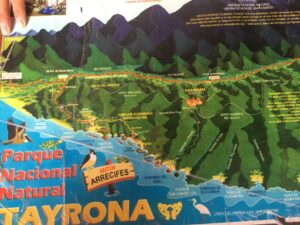
Tayrona National Park accommodation
In the park, don’t expect any flashy accommodation – it’s a natural area where nature is the most important. But I suspect you don’t go to Tayrona for luxury anyway. However, important info: there’s no hostel in Tayrona Park.
It’s possible to book accommodation (camping and basic bungalows) right at the Tayrona park entrance, but that’s more expensive. If you’re ready to stay in a tent or a hammock, there’s really no need to book your accommodation ahead; there will be space.
Another thing to keep in mind: some accommodations offered to visitors at the entrance are actually outside the park. So if you consider arranging your night before entering the park, make sure you ask about the precise location.

Camping in Tayrona National Park
This is the form of accommodation that most travellers choose. Who wouldn’t want to embrace the jungle with all its colours and noises in a tent or in a hammock? Camping in Tayrona Park can be done either in a tent or in a hammock; both of them can be rented or you can bring your own. Before you ask, wild camping or sleeping on the beach is absolutely prohibited.
It’s important to start the hike early from the park entrance (8-9 am), especially if you arrive without your own tent, as tents and hammocks reservations work on a first come, first served basis. Unfortunately booking a hammock or a tent beforehand is not possible.
Shower and toilet services are rather rustic and cooking may be possible only if you set a fire yourself. The camping place provides a cooking pot.
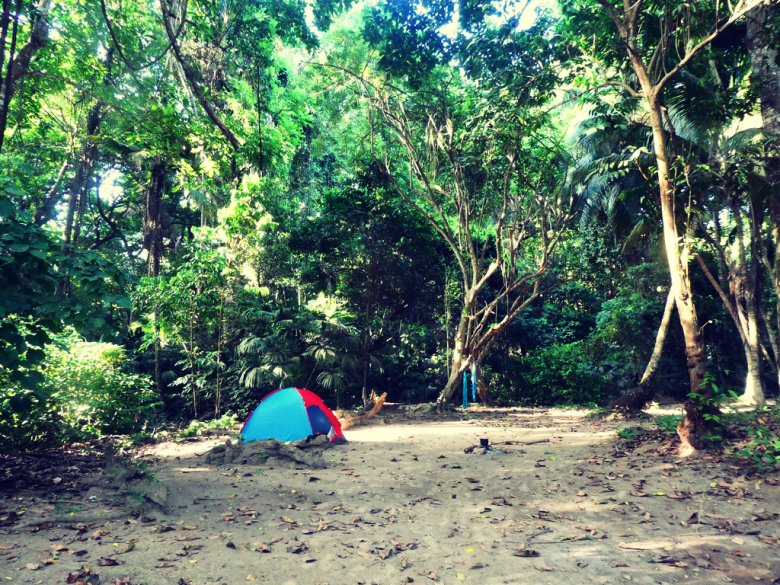
Camping places in Arrecifes
While we were exploring Tayrona National Park we passed by a few camping places, all with a similar level of service. Camping Don Pedro and Yuluka are the most famous ones. Don Pedro is the only one that is marked on the map.
Our Couchsurfing host in Santa Marta recommended us to stay in Jacobo B as the cheapest alternative, 15 mins walk from the beaches. We had our tent (that we actually borrowed from our host) and stayed there 2 nights.
Camping at Cabo San Juan, Tayrona Park’s most famous
As it’s also the most famous beach, the camping place is the most expensive within the park. There are tents and hammocks already set next to each other like sardines in the tin.
For a higher price, you’ll get to sleep right on the beach and will be next to restaurants and other amenities. Like alligators. They’re included in the price.
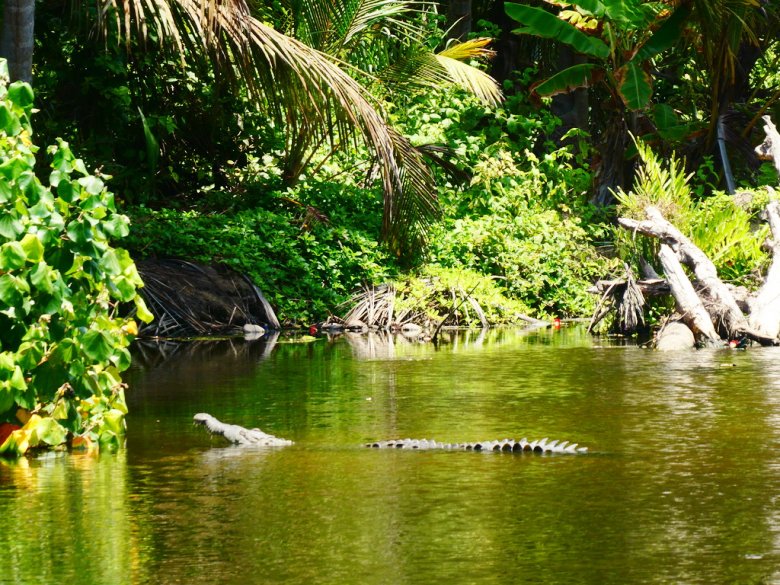
Bungalow accommodation
Ecohabs bungalow resort
The most luxurious accommodation in the park is Ecohabs; stylish wooden huts with hay roof where all kinds of hotel services are available, such as WiFi, laundry, pool, even hot tub! It’s basically a bungalow resort 15 minutes walk from Playa Canaveral. It has good ratings, but the price is not exactly backpacker-friendly.
Basic bungalows
There are a few basic wooden bungalows in Tayrona in the Arrecifes sector. The number is really limited and is expensive. These can be booked in advance, upon arrival to the entrance.
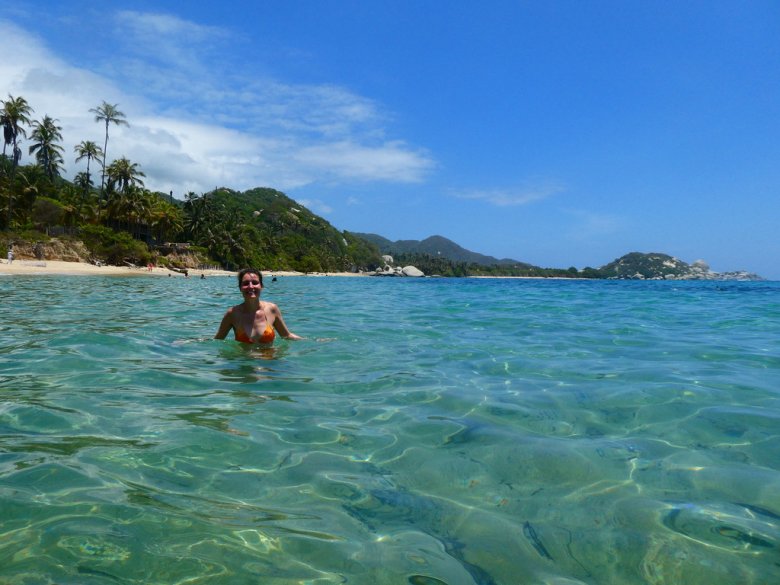
Beaches of Tayrona National Park
The camping you’ll choose within Tayrona Park will largely be influenced by which beach you want to spend most of your time at; and how much walking you agree with. Now, there are a lot of beaches in the park and I believe that everyone will find their cup of tea.
There are three entrances to the park and we can access different beaches from them.
- The most popular entrance, the one overnight visitors choose, is El Zaino in the east. There’s about a 1-hour hike through the forest on a built-out trail until you reach the first beaches. From here the trail turns into a coastal walk that stretches through numerous amazing beaches.
- Palangana entrance can be reached from Taganga by boat. This entrance is more popular with day-trippers.
- The third entrance at Calabazo leads to the middle of the park passing through Pueblito, the biggest indigenous village inside the park. If you want to take the Calabazo entrance, check ahead if it’s possible to visit Pueblito.
The most remarkable beaches in Tayrona are reachable from El Zaino. They are divided into 3 sectors: Canaveral, Arrecifes, Cabo San Juan.
Keep dreaming: Our ultimate guide to the best beaches in Colombia
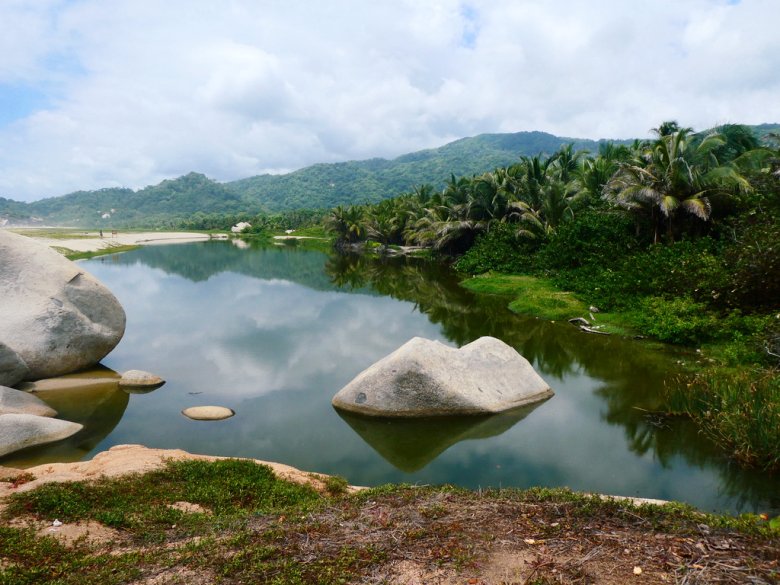
Beaches at Sector Canaveral
Playa Canaveral
It’s the first beach that you reach coming from El Zaino. There is a beach bar serving drinks and more people than on other beaches.
La Piscinita
A small, tucked-away beach between Canaveral and Arrecifes. Sometimes it’s not possible to swim here – then it’s marked with a red flag.

Sector Arrecifes
Playa la Arenilla
If you are staying at the camping at Arrecifes, this is the first beach you’ll reach when visiting Tayrona National Park. It’s a relatively calm beach without many people where it’s possible to swim. But the shade is quite far from the water and the sun can be strong in that area.
Playa la Piscina
Don’t mix it up with La Piscinita! Piscina is a popular beach with a long sand area and enough shade. One can swim here. It’s only a 10 min walk after Arenilla.
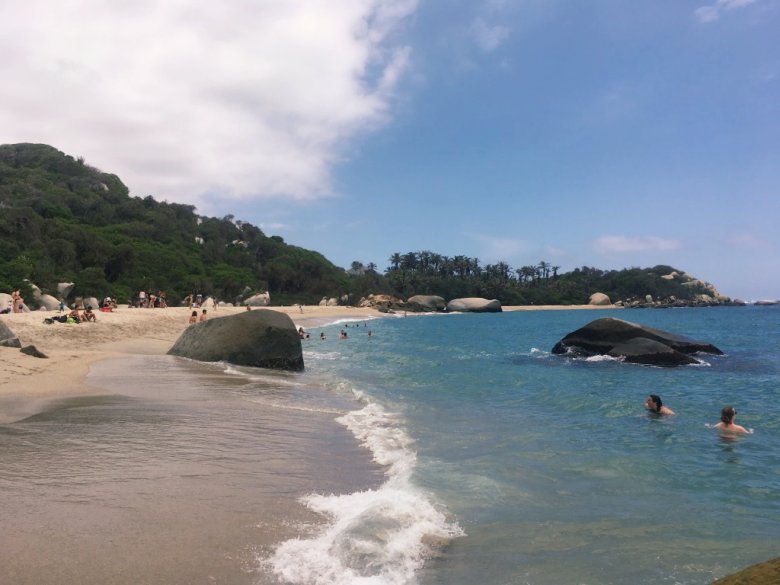
Sector Cabo San Juan
Playa Cabo San Juan
This is the most famous and most popular beach. We were surprised by the number of amenities built here, on the territory of a natural park. You can find here everything you need, provided you came with enough cash: breakfast, lunch, cooked dinner, snacks, drinks, beer, cocktails, souvenirs, beach towels.
There’s a building on a small peninsula with hammocks and private rooms. In the busy camping, tents are erected very close to each other. Don’t walk at night to the swampy area just at the beach because alligators live there (we saw one!). This is the single most popular beach in Tayrona, the water is literally full of people.
You can also reach Cabo San Juan from the Calabazo entrance after 2 hours of hiking.

Nudist beach
The furthest beach on the coastal path. Actually, there are two beaches right after each other, might be both nudist. We don’t really know, as both beaches were quite empty, with only a few people; most of them were in full swimming suit.
Although it’s not possible to swim in any of them, people disregard it. There’s a shade to chill. It’s about 15 minutes walk from Cabo San Juan.
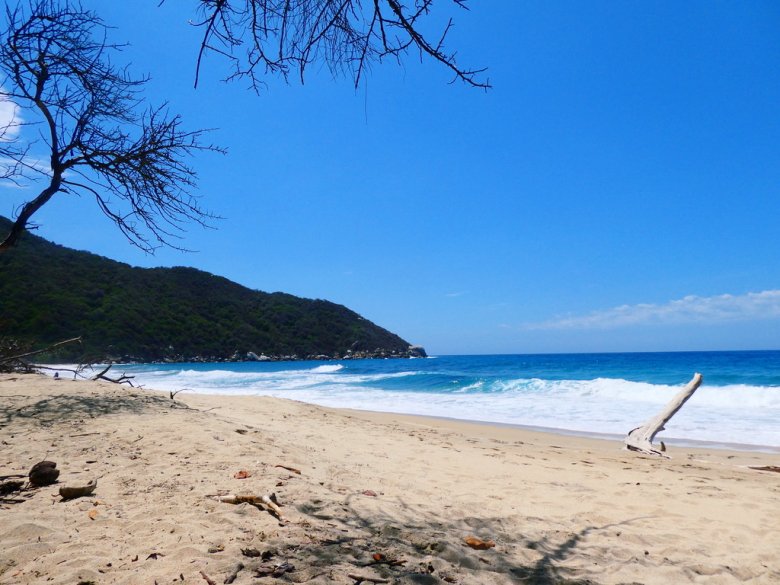
Beaches accessible from Palangana entrance
Neguanje
It’s a large beach in front of a mountain backdrop, providing an idyllic place to swim and sunbathe. However, many visitors continue walking to the more secluded Playa Cristal from here.
Playa Cristal or Playa del Muerto
A popular beach which can be reached from Playa Neguanje on foot. Considered one of the prettiest beaches in Tayrona, it’s definitely not as deserted as others in the park. Visitors can come here by boat too from Taganga.
Playa Gayraca
It’s an often empty beach with white sand and palm trees in the backdrop. It’s great for snorkelling and diving as the marine life and coral reef is excellent. Nearby is the Mirador 7 Olas (“7 waves lookout”); don’t miss that, it offers a splendid view on the sea and the beaches.
Bahia Concha
Although Bahia Concha is officially part of the Tayrona Park, since June 2019 there’s no need to purchase an entrance ticket (only the obligatory insurance) to access it. This means a long-awaited alternative for budget travellers who’d rather save that money, but surely more people on the beach. You can reach the coast with a hike from the entrance.

Only beach accessible from Calabazo entrance
Playa Brava
A really quiet but pretty beach, a fair trek from the Calabazo entrance. It’s also reachable from Cabo San Juan with a 3-hour hike. There’s a restaurant and accommodation in hammocks and bungalows at this beach.
What to bring for camping in Tayrona Park
It’s really hot and humid in the park both day and night, so we didn’t need any warm clothes, only a thin sleeping bag. Most of the things we brought with us were food to cook (see our shopping list below) and water. Other things you’ll need:
- Torch, unless you are ready to go to sleep early, as the sun goes down at 6 pm. If you need one, check out this hands-free headtorch.
- Swimming suit
- Towel – we always bring our travel towel, which is ultra-small and quick-dry, like this colourful large travel towel
- Hat
- Sunscreen
- Hiking sandals or boots – my favourite hiking sandals are from Teva
- Toilet paper
- Soap / shampoo
- Rain jacket
- Change of clothes after the beach
- Camera
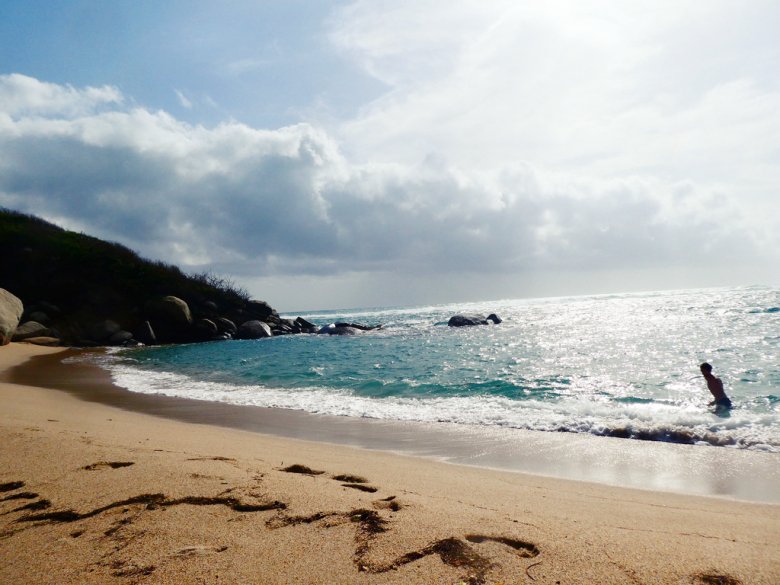
Eating in Tayrona Park
Buying food on site
Obviously, the easiest option is to buy food in the park. There are basic restaurants at almost every beach where home-cooked food made of locally sourced ingredients is served at high prices. A small can of beer cost 6000 COP, a 1.5-litre water 5000 COP in 2019.
Cooking at Tayrona
If you are counting your cash, the cheapest way is to cook yourself. Of course, there’s no fridge in the camping, so bring food that resist a humid environment. This was our shopping list for 3 days in Tayrona Park:
- Bags of pasta
- Tins of carrots and peas
- Packaged cake
- Infinite amount of crackers
- Muesli bars
- Arequipe, the Colombian dulce de leche, a sweet spread for bread (and cake. And crackers.)
- A bag of crisps – although we don’t eat crisps
- Nuts
- As much water as possible or a water filter.
- Matches to make fire
It’s possible to get fresh water from the shower. But after some sickness under our belt due to bad water, we didn’t trust non-purified water. For occasions like this, we would have absolutely loved to have a water filter!
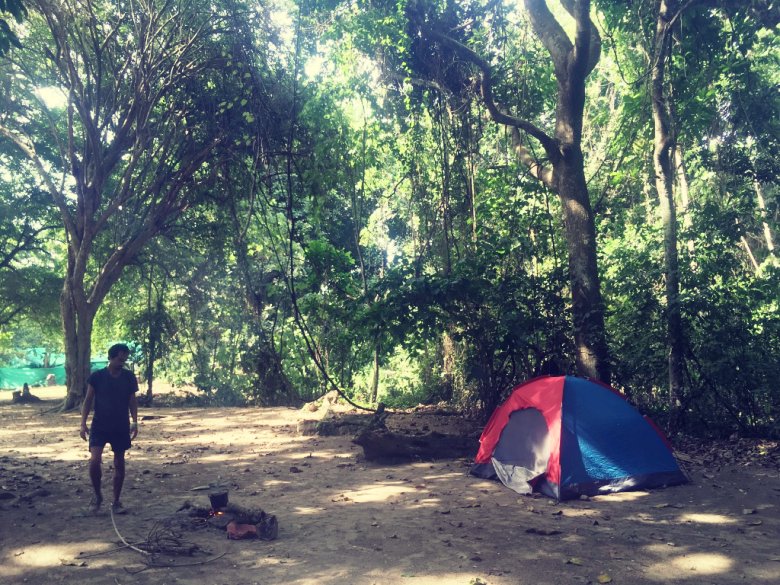
Eco travels while camping in Tayrona Park
In a protected area, being ecological is even more important than at other places. Here is our best advice:
- Try to produce as little rubbish as possible: waste handling in the park takes more effort than in cities and there’s no recycling
- Bring your own reuse cup in case you want a cocktail
- Limit your showers to the minimum to preserve freshwater. An early morning swim will do the trick.
- Don’t wander off the marked trail
- Use reef-safe sunscreen
- Be respectful of indigenous people if you happen to meet them; sometimes they work with visitors, for example as guides or selling freshly-pressed juice
- Respect their sacred places – if it’s closed, don’t attempt to go there
Read further: All our eco travel tips for Colombia, and anywhere in the world.
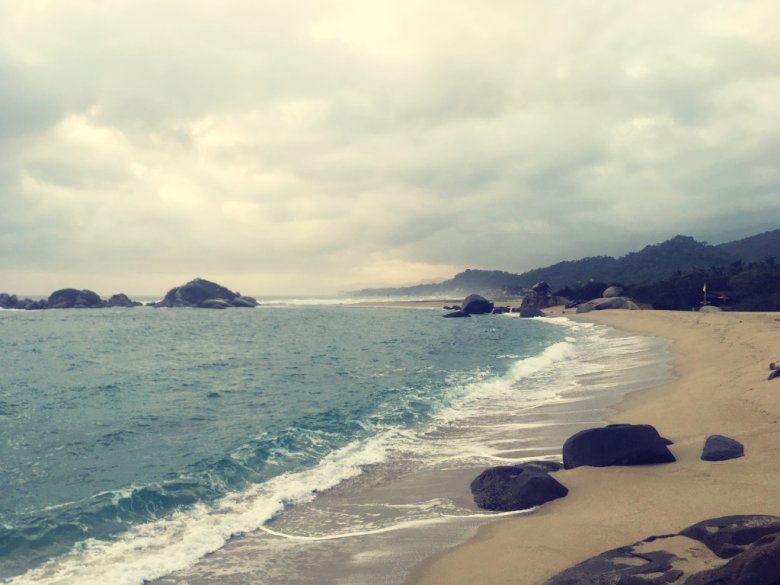
What to do in Tayrona Park
Tayrona is such a magical environment, so to be honest what we did most of the time was exploring beaches and hiking the trails. But there are other amazing activities to indulge in too.
Horse riding
If you’d like to explore parts of the park on a horseback, locals offer horse tours. Ask at the entrance or at your accommodation where to book these.
Hiking
Well-marked and well-preserved trails are tempting you into exploring the park on foot. Keep in mind that you’ll get tired sooner than normal, due to the high humidity. A very nice hike right after the entrance is the Sendero de las 9 piedras (9 stones trail) that leads to 2 lookouts and a completely empty beach where it’s forbidden to swim.
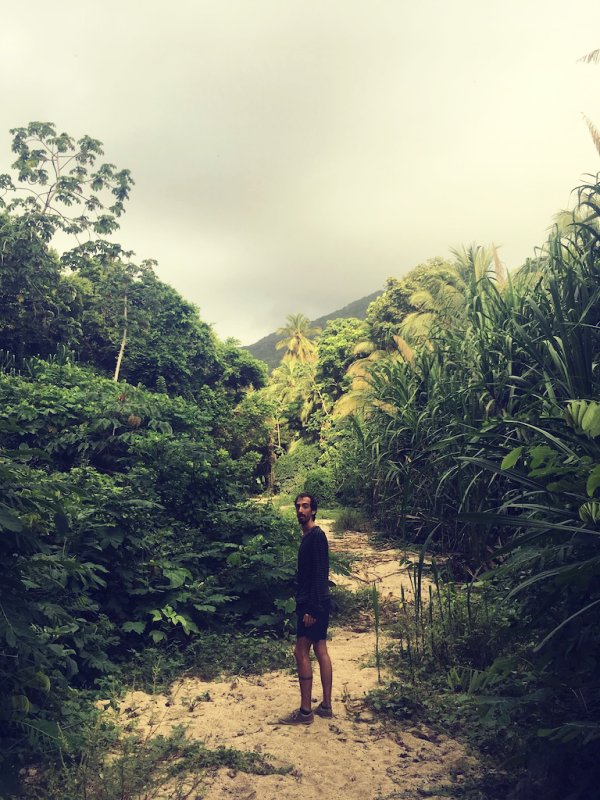
Beach hopping
Discover the beaches and splash in the crystal clear and warm water at each of them, while sharing the white sand either with fellow travellers or only with coastal birds. If you are rather a sunbather, consider choosing beaches where swimming is forbidden for some me-time. Another tip for those who want to avoid crowds: go early to the beach, before the day-trippers arrive around 10:30.
Visit the Museum Chayrama
This museum at the trailhead at El Zaino exhibits about the park and the indigenous communities. The entrance is included in your park ticket price. At the time of our visit, it was closed.
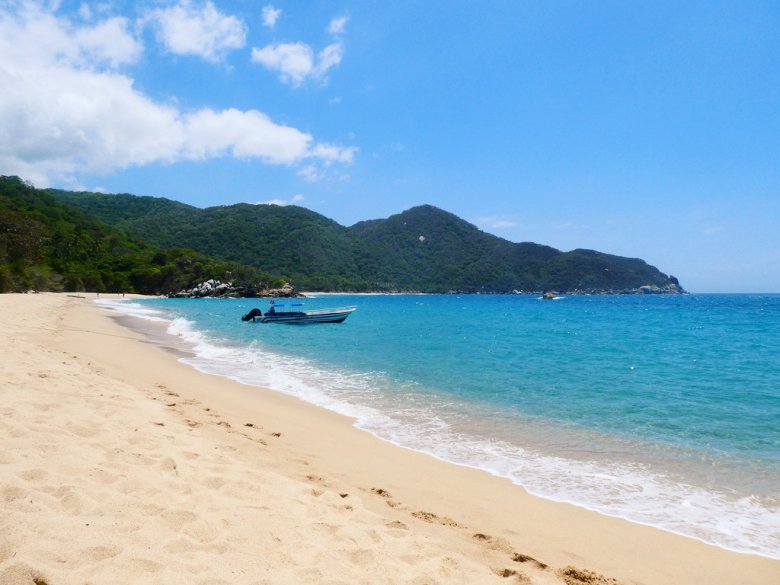
Explore further beaches with a boat tour
Are you dying to see beaches where the trail doesn’t lead to? You can check out very secluded beaches and coastal parts on a boat tour organised by locals. Ask for details at the entrance or at your accommodation.
Guided tours
There are guided tours available within the park, where one can learn about the special flora and fauna. If you don’t speak Spanish, make sure you request an English-speaking guide. Ask about this possibility at the entrance.

How to get to Tayrona
The most obvious starting point to Tayrona is Santa Marta, the city that’s closest to the park. If you are anywhere else in Colombia, head to Santa Marta first.
There are direct bus services from Santa Marta to Tayrona Park which will drop you off at El Zaino entrance. As of June 2019 bus tickets cost 10,000 COP one way.
What time does Tayrona open
Tayrona operates with strict opening times: 8 am–5 pm. Outside of these hours, no one can go in or out of the park, so plan your day accordingly.
If you are a camper without your own tent or hammock, you want to take up your sleeping spot as early as possible; so be there between 8 and 9 to start your hour hike from El Zaino. The best spaces book up fast, especially at popular campsites like Cabo San Juan.
Tayrona National Park tickets
The entrance fee to the park in 2022 in the high season: 68,000 COP (15€ / 15$), and low season 57,500 COP (13€ / 13$), payable only in cash. With the ticket, you can stay as long as you want inside the park. Besides that, you only need to pay for the accommodation, plus a 3500 COP fee for obligatory insurance.
You’re supposed to pay this fee per day you’ll spend in the park. But several people advised us to say that we were staying only 1 day in the park, in order to pay it only once.
It’s not possible to pay the entrance ticket (nor anything inside the park) by card, so prepare with more cash than you expect to spend. Worst case scenario, you can withdraw money at the entrance, but that comes with a 10-15% fee.
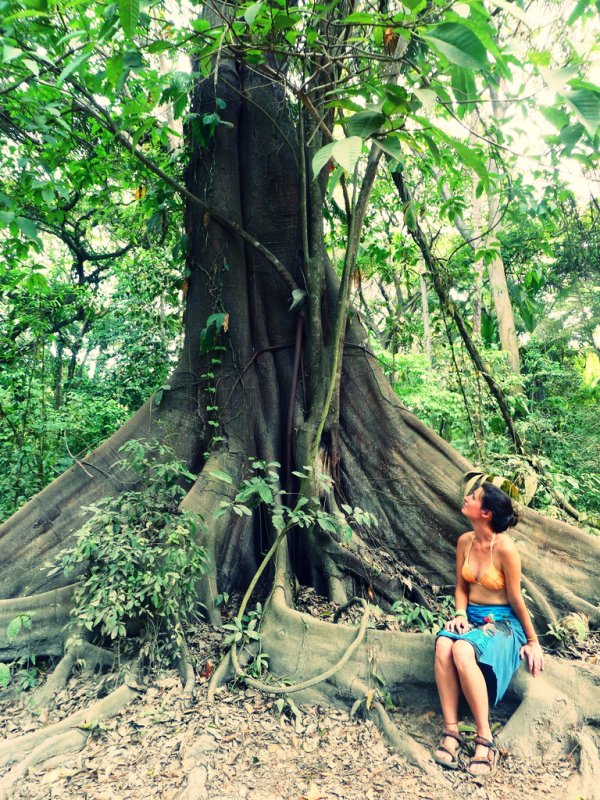
In conclusion
Tayrona park was my best experience in Colombia, it’s truly a paradise-like natural reserve. However, it has its price to budget in. Many people continue to Palomino, which is another beautiful beach near Santa Marta, or they hop on a bus and drive to further beaches.
Travelling further in Colombia? Read our Colombia backpacking guide.
★
What was your experience camping in Tayrona Park?
Share your story in the comments below!
Like it? Pin it!
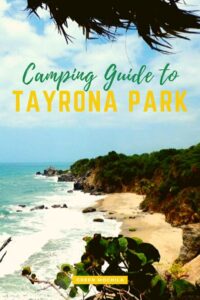
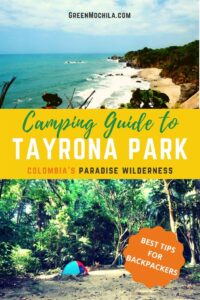

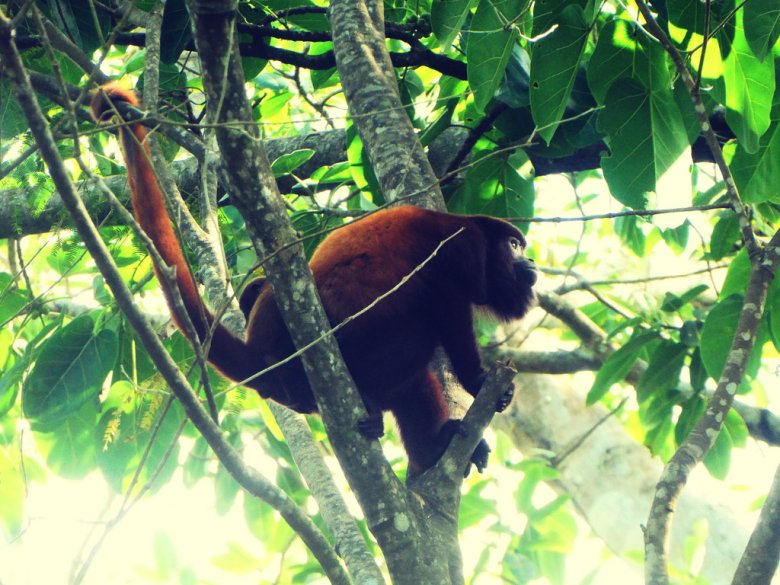
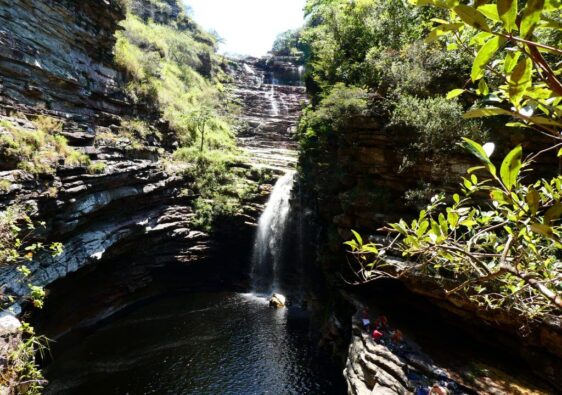



The scenery and photos are breathtaking. I must admit I am not a camper. The fact you need to stay in a tent or hammock and the bathrooms are rustic would make camping here a no for me. I am a bit of a snob!
That’s totally understandable, Chris. In that case, you would find a bit more comfort in the eco lodge within the Tayrona Park, or just visit for a day.
Tayrona NP looks absolutely beautiful, and isn’t a destination I’d heard of before. I visited Colombia briefly about 30 years ago but we focused on cities and cultural sights and missed the beauty of the natural landscape. Amazing that this paradise was not busy and you could find peace and quiet, and empty beaches!
Everybody says Colombia has changed a lot in 30 years. Some areas weren’t open to tourism back then. You should definitely go back!
Wow! Tayrona Park sounds like a true hidden gem!! I’d love to do some rustic camping, but what about the alligators!? Do they come into the campgrounds!?
“Hopefully not” is the only answer we can give you, Lisa. But I guess they don’t, or the world would hear about it. Thanks for stopping by!
Wonderful post! I can see why you love these beaches as they look breathtaking! Such great info and detailed tips on how to visit. I will save this for when I get the chance to visit Colombia. 😁
We hope you make it there soon, and think of us (just a bit) when you relax on one of Tayrona’s beaches 😊
Wow…. looks like paradise!
I could spend some time at Tayrona
So many things to do! I especially liked that colombia isn’t so packed with tourists :):)
Thank you for writing such a detailed guide! I may go to Colombia in April so I’m saving this in case I decide to go to Tayrona.
If you have nothing against camping, it shouldn’t be “in case you go” but “when you go”😊. We promise it’s an unforgettable experience!
This sounds amazing! It is sometimes hard to make a call whether to visit somewhere or not. When we were in the states, we were shocked at the entrance prices to some of the attractions (Alcatraz cost 40$ to visit!) but as you say you never know when you will be in the area again. I am pleased it was not too overrun with tourists and it looks stunning <3
That’s another thing: some attractions get so much attention, you start expecting bad things. Parque Tayrona was a lovely surprise!
Tayrona National Park looks like a slice of heaven on earth! And while I’m not much of a camper, I’d be so excited to see monkeys, alligators, and other creatures hanging out in their natural environment. How cool is that?
Absolutely! We were so happy seeing those animals finally, after so long traveling in South America and not being lucky. Especially the monkeys, they were so sweet 🙂
You should take part in a contest for one of the best blogs on the web. I will recommend this site!
I simply want to mention I’m beginner to blogging and site-building and absolutely loved your web site. I’m likely to bookmark your blog. You definitely come with tremendous articles. Thanks for sharing!
All your posts are really an inspiration to discover South America!
so in the end staying in a tent in tayrona park doesn’t seem to be that expensive. cool!
You guys are really passionate about the places you describe. This article sure makes me want to travel to Colombia right now and pitch my tent in the Tayrona Park!
I really hope I’ll be able to overnight in the Tayrona park during my trip. That nature is stunning, your photos make me drool!
Hey there, thanks for your message! We also hope you’ll make it, because camping in Tayrona National Park is really an unforgettable experience.